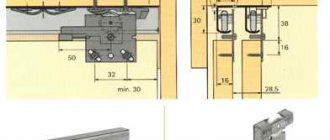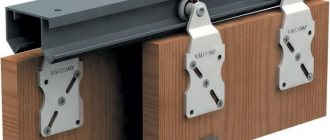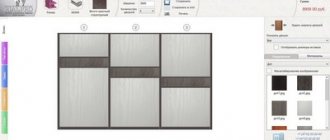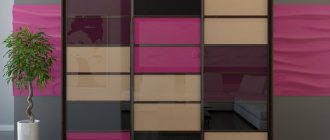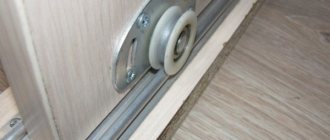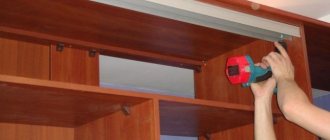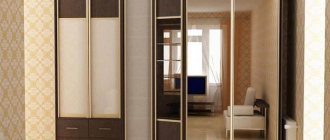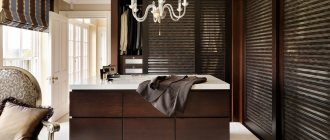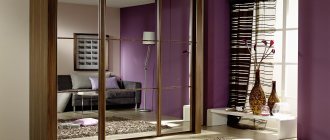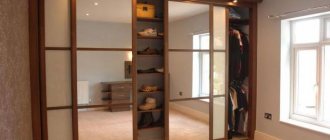Interior doors are designed to separate different occupied spaces in a residential or public space. Such products are subject to increased requirements to ensure sound insulation properties.
When installing doors in a dressing room, there are no such requirements, and the main selection criteria are attractive appearance, ease of operation and increased reliability. Before you buy or order sliding doors for a dressing room, you should study the features of the mechanism in order to achieve the expected result during operation.
What is it and how does it work?
The hanging system for sliding wardrobes is a set of sliding doors equipped with top-supporting or bottom-supporting rollers. It consists of an aluminum profile with a special coating. The system includes closers that allow you to close the doors carefully. The need for its appearance was dictated by the living conditions of many apartment owners and their families who do not have significant living space: it allows rational use of living space.
The hanging system for sliding wardrobes is a set of sliding doors equipped with top-supporting or bottom-supporting rollers.
The choice of the “right” one is determined by ideas about comfort.
Doors installed with this system move from the outside of the structure.
Location Features
Based on the location of the wardrobe compartment door, they can be divided into:
- Straight-line;
- Angular.
Most often, the dressing room has a rectangular shape. In such cases, doors of a straight-line compartment system are installed at the entrance. However, in some cases, when a corner part of a room or room is allocated for a dressing room, it is necessary to use a corner-type sliding door system. Each installation system has a number of unique features.
Types of hinged doors
This:
- Hinged door. The canvas is suspended on the upper fittings and fixed on the lower one;
- Support door. The wings are supported by the lower rollers, and the upper fittings are used to fix and support the door. They are easier to install and cost less, but the sashes may have play relative to the line of movement.
- Combined. The shutters are fixed on both profiles (there is no play). The design is the most reliable and expensive.
The design has proven its versatility, which is why it is used in the manufacture of sliding wardrobe doors, which can be installed in any room of the apartment.
| System type | Peculiarities |
| Roller | The roller is located inside the rail guide, which ensures that the cabinet door opens neatly. It has two types of roller mounting – upper and lower. |
| Framework | Made from aluminum or steel. Aluminum profile is considered more resistant to abrasion, so it costs more. |
| Frameless | Budget version of the sliding system: the most inexpensive, but also short-lived. Deforms due to temperature changes or high humidity. |
| For radius cabinet models | Used for furniture with a non-standard configuration |
How to make a dressing room with your own hands
Of course, the easiest way is to entrust the work of creating a dressing room to professionals, but if you don’t want to overpay, then you can take matters into your own hands. Beforehand, it’s worth watching several training videos to evaluate the intricacies of the work and take into account problems and errors that may arise.
The initial stage is the development of the drawing. You need to determine the size of the dressing room. This could be a room left over from a former storage room or a niche (corner) in one of the rooms. All measurement results must be carefully recorded and supplemented with a schematic drawing for a rough understanding of which measurements relate to what.
Based on the dimensions of the future room, you can already roughly imagine the parameters of racks, shelves and other elements that are supposed to be placed in it. It is necessary to take into account some nuances. The depth of the shelves should not exceed 50 cm, as it will be difficult to reach their edges. The distance between them should be about 35 cm and so on. You should also think through the nuances of lighting in advance.
You can use ready-made diagrams as an example or copy them completely if the dimensions on them coincide with the parameters of the future dressing room
You need to decide on the availability and format of the door. There are models:
- sliding;
- accordions;
- swing;
- coupe;
- mounted
You can do without them altogether or prefer thick curtains.
The installation process must be carefully verified, elements must be securely fastened and high-quality materials must be selected in order to obtain a functional room.
Drawings and diagrams
If the dressing room is made with your own hands, then you cannot do without diagrams. They think through and calculate:
- room dimensions;
- arrangement of shelves and their number;
- door parameters;
- finishing materials and fastenings;
- installation of retractable structures;
- expenses;
- planning of ventilation and lighting systems.
Below are a few diagrams that can be used as ideas.
The simplest dressing room is 2.5 meters high and 1.3 meters deep. You can place an ironing board in it. There is a separate space for shoes and clothes, household items and other things.
The diagram includes all the approximate parameters for building a dressing room
Option for a different type of dressing room. Storage spaces in it are located along two walls (left half of the picture) or three (right half of the picture).
All shelves in the wardrobe type are located on one wall
The storage system will be convenient if the space for its installation is shallow but long. In addition to the usual shelves and hangers, the diagram shows an example of installing drawers for storage.
The structure of the dressing room allows you to differentiate it by type or season, and use shelves for accessories
A dressing room with maximum variety in the type of placement of clothes and accessories. There is a section with a pull-out trouser bar, racks for bags and shoes, and several hangers for clothes.
A small compact space will allow you to fit a large number of things and unload other rooms
A small dressing room with a minimal set of shelves. Suitable for installation in a pantry.
Corner dressing room allows you to save free space due to the beveled edge
The dressing room can also be located in the corner of the living space. Although its size is small, it helps to save space in the room due to its functionality.
Required tools and materials
After creating the diagram, you should take care of the materials and tools used. Information obtained during design will be required.
The following items are required:
- rack and guide profiles (for limited space, small thicknesses are needed);
- moisture-resistant plasterboard for covering partitions with a thickness of 12–15 mm;
- mineral wool or other materials to fill the frame space;
- putty and mesh to strengthen its layer;
- paint or wallpaper;
- drill;
- screwdrivers;
- dowels;
- screws;
- Wall panels;
- lighting fixtures (you should give preference to LED strips and several point light sources);
- wires for laying wiring;
- sockets;
- switches;
- fittings for storage systems, doors and other things;
- shelves, racks, mirrors and other elements for filling the wardrobe.
Step-by-step instruction
The construction of a dressing room also has its own nuances. If installation is planned in one of the corners of the room, then the walls are created from profiles and sheets of plasterboard. After completing their installation and zoning the shelves, you can begin attaching the door.
The sequence of actions for installing a dressing room is as follows:
- To begin with, markings are applied to those areas of the wall to which the structure is planned to be attached. This must be done using a meter and a building level.
Markings for fastenings should be made frequently to make the design more accurate
- Using a drill, holes are created for the dowels in the already selected places. The profiles are fastened using screws. The dowels, accordingly, are driven into the holes made. The entire process is carried out quickly and reliably.
- The ventral posts must be mounted into the fixed guides. The distance between them is 60 cm.
- If you make the rack yourself, then you should first apply markings that will determine the design parameters. It needs to be done on the walls and floor. Next, the guides are installed. They must be mounted with their backs on the base base to form grooves for the posts. As a result, the resulting structure is sheathed with plasterboard or slabs.
At the site of the proposed future door, it is necessary to strengthen the structure by installing lintels
In addition to the above option, mounting a wardrobe can also be done using a wardrobe rack. You can buy it at a furniture store or make it yourself from plasterboard or chipboard.
The dressing room can be in the form of a pencil case. The number of shelves and hangers in such a system is determined by the number of people who will use it.
The creation process begins with measurements and acquisition of materials. The hanger is assembled first, and then special rollers for installing the door. The rear and upper walls are fixed. The hanger is retracted and the sidewall is made.
One lamp installed in the ceiling is not enough for high-quality lighting of the dressing room
After the formation of the future dressing room, you can begin finishing. Sheets of cardboard are attached to the frame. The entire structure is puttied using self-adhesive tape, which avoids the formation of cracks. The material is laid in two layers. After it, primer is applied, which increases paint adhesion. And finally, the surfaces are painted, wallpapered or paneled.
In the process of finishing the wardrobe, it is necessary to take into account the need for ventilation and lighting. A small gap is needed under the door for air to enter; when constructing partitions, technical gaps must be left; small holes can be made in the walls above the baseboards. For good lighting, it is most convenient to additionally attach LED lighting strips to the shelves.
How to make sliding doors
The most common type of door for a dressing room located in a room is a compartment. They move along guides parallel to the wall. When opening, their parts can slide one after another (the number of elements is two or more). If the front side of the proposed room is large, then you can leave a stationary wall and make part of it with doors.
Door sizes are selected depending on the selected drawing
It is necessary to take measurements of the doorway. This must be done using a plumb line, tape measure and level. We put marks at the corners of the opening and in the middle to find out exactly the required size for the future door. The approximate width of the guides is 10 cm. This distance should also be measured in the depths of the niche. Based on the measurements, you can draw up a project and select the necessary materials for installation.
It is best to purchase ready-made furniture systems in a specialized store. The minimum and standard installation kit includes:
- metal profiles;
- roller mechanisms;
- plugs;
- gaskets;
- jumpers;
- fastenings
You will also need material for the doors themselves:
- sheets of clear or tinted glass;
- mirrors;
- plastic;
- Fiberboard or MDF;
- other materials.
You can purchase them either separately, having previously calculated the required size so that the door does not turn out to be too small or large, or together with a fastening system. In the latter case, problems with mismatched dimensions can be avoided.
The doors will need to be assembled according to the instructions. More details can be found in the video below.
Video: installing sliding doors
What is special about the hanging system for sliding wardrobe doors?
Anyone who plans to order a wardrobe is faced with the problem of choosing a system for sliding doors: bottom-supported or suspended (top-supported). The latter consists of:
- top guide with rails;
- roller carriages;
- locking mechanism.
The hanging system for sliding wardrobes appeared on the Russian market not so long ago, but has already managed to win the enormous sympathy of customers. The peculiarity of the top-support system is that the sliding doors are suspended on the upper guide, which holds the entire structure. The doors do not move inside the cabinet, but in front of it. The guides are attached either to the ceiling or to the roof of the cabinet. Installation of the suspension system is quite simple and does not require additional milling of the doors. However, during installation, it is important to take into account the quality of the plane on which the guide profile is attached, since it may not withstand heavy loads.
Typically, hanging systems for sliding wardrobe doors are used for interior partitions and built-in wardrobes, because due to the absence of a bottom guide, unnecessary and inconvenient obstacles are not created on the floor. In addition, dust constantly accumulates inside the rail with the bottom guide, which makes it difficult for the doors to move. There are no such problems with the top guide.
Briefly about the main thing
Sliding doors for a dressing room are the optimal solution for decorating a space intended for storing personal belongings. Sliding doors always look stylish, match the overall style of the room’s interior, and also do not require any free space to open.
Sliding doors are considered a classic version of such structures, and when decorating a space with a thematic slant, barn doors or folding structures are suitable.
When choosing a color, you should pay special attention to the style of the finish, and also rely on personal preferences, given that such products are installed with the expectation of many years of use.
Materials for the manufacture of suspension systems
To ensure that the suspension system remains reliable for many years, stably withstanding serious weight and inertial loads, its elements are made of high-strength modern materials:
- profiled guides - made of high-strength aluminum alloys;
- rollers are made of abrasion-resistant and elastic fluoroplastic;
- rolling bearings are made of special steel, hard and resistant to shock loads;
- fasteners are made of stamped alloy steel.
This approach is practiced by well-known European manufacturers Krona Koblenz, Cinetto, Hettich and some others. Systems produced under these brands allow the use of heavy door leaves made of solid wood, MDF panels or thick tempered glass. Most often they are installed in wardrobes, but in recent years sliding doors between rooms, where highly reliable hanging systems are also used, have become increasingly popular.
Assembling the door leaf
If you purchased a ready-made sliding door, for example, like the one in the photo, then you can begin installing it in the grooves of the tracks. If you decide to make it yourself, you will have to first assemble the canvas itself.
First you need to choose what material the door leaf will be made of. It could be:
- plywood,
- laminated chipboard,
- glass,
- tree.
Now you need to take measurements of the doorway of the dressing room, pantry or closet with a tape measure and, with your own hands, cut the door leaf to size from the material you have chosen. After this, attach all the parts needed for assembly to the canvas:
- rollers on top and bottom,
- horizontal profile on both sides,
- lower and upper frames.
Advantages and disadvantages of a hanging system for sliding wardrobes
This design has gained great popularity due to a number of reasons:
- the room is provided with a neat aesthetic appearance, since all things are securely “hidden” in the closet;
- space saving is ensured;
- the loss of running carriages is prevented due to the strong fixation of the array in the doorway and the shape of the profile;
- an atmosphere of comfort is created when using sliding wardrobes due to the silent movement of doors;
- allows each door to withstand loads of up to one hundred kilograms.
The design has proven its versatility, which is why it is used in the manufacture of sliding wardrobe doors.
The bottom-support sliding system is installed in a mortise or overlay manner, which allows the door section to be installed to the floor.
The reason for this was initially the ease of use in small apartments.
Attention! Among the disadvantages, experts note the rather high price of cabinets with top rails. They require mandatory design of the upper part of the door, since its structure is open. Installation of the product will be much more difficult, compared to bottom-mounted ones.
This design has gained great popularity.
The system includes closers that allow you to close the doors carefully.
The roller is located inside the rail guide, which ensures that the cabinet door opens neatly.
And if they are decorated with mirrors and inlays, this adds aesthetics and gives the room originality.
Why do you need a dressing room?
A dressing room is a room designed for storing and organizing clothes, shoes and accessories. Often they are supplemented with sports equipment or some household items, for example, additional blankets, pillows or equipment. These are rooms that are equipped with storage systems. Sometimes closets or separate suitable parts of the hallway are converted into a dressing room. Such premises are multifunctional and their use brings additional convenience to the inhabitants of the house.
A dressing room allows you to rid your home of large closets, chests of drawers and massive cabinets with clothes
You can build a retractable ironing board, mirror and other additional tools into the dressing room that will make life more comfortable.
The best models of the hanging system
There are products from many manufacturers on the market. The best models are:
- Aristo is a high-strength profile with a wide range of colors. Estimated service life up to 30 years;
- Versal – perfect dimensional accuracy of profiles, easy installation. Estimated period of use is up to 18 years;
- Komandor - with increased tensile strength and a more advanced design of the lower roller.
HfTTich, Hafle and Marbella profiles are also popular.
Thus, an atmosphere of comfort is created when using sliding wardrobes due to the silent movement of the doors.
Important! It is not recommended for specialists to buy cheap models. The design is not particularly reliable and can quickly fail. There will be more problems instead of convenience and efficiency of use.
Sliding wardrobes are compact, multi-functional, large capacity, and easy to use. They replace numerous cabinets with doors. The hanging system is an ideal solution for attaching door leaves. Convenient and aesthetically attractive conditions are created for access to the contents of the cabinet and for its smooth closing.
Advantages of equipping a wardrobe in the hallway
The obvious advantages of arranging a dressing room in the hallway include:
A large number of shelves, racks, hooks, hangers allows you to store a lot of personal items and accessories. In this case, the upper tier of the wardrobe can be occupied by a mezzanine, which also acts as additional storage space. Even a small dressing room in the hallway can accommodate a large number of personal items for storage.
The placement of such furniture near the front door is quite reasonable, because in rainy or snowy weather things and shoes can be dried directly on the lower shelves of the dressing room. For this reason, most of these structures are equipped with metal or plastic racks for drying shoes.
As a rule, durable, moisture-resistant materials are used for interior decoration of the hallway, which do not deteriorate at all from excess rainwater or melted snow.
Space saving. The corner dressing room in the hallway is quite compact in size, allowing you to significantly save space.
The facades of a closed wardrobe can be decorated in an original way using PVC films with imitation of various materials, decorative painting or veneer. As an alternative, you can install a full-length mirror on the front door, which gives you the opportunity to assess your appearance before leaving the house.
The advantages of a built-in dressing room in the hallway also include the possibility of independently building the structure. To do this, the master will need a minimum set of construction tools, wood, fittings and a well-prepared drawing.
Features of the suspension system for heavy doors
The classic hanging system for a door is a rail attached to the top lid of a cabinet or the top trim of a doorway, along which rollers move with the door leaf suspended on them. Thus, the entire weight load falls on the rail and the upper supporting element of the structure. At the bottom of the cabinet or doorway there is a bottom rail, which serves as a guide and limiting element, preventing the panel from swinging on the suspension. Rollers slide along the bottom rail, attached to the lower end of the door leaf and not bearing any weight load.
Designers of sliding systems focus on safety and comfort. This is why it is recommended to use suspended rather than support options. By using a support system, the consumer is not free from the danger of the door tipping and falling under certain circumstances. In addition, the lower guide often becomes clogged, which disrupts the smooth operation and creates obstacles for opening and closing.
For suspended systems, the danger lies primarily in the inertial force possessed by a massive door sliding on rollers. However, today we have learned to deal with this problem with the help of:
- patented shock-absorbing devices that are built into the carriage with rollers to absorb vibrations and soften the movement of the web;
- soft closing systems that protect hands from being hit by the door;
- locking devices that absorb the shock load when the end of the door leaf comes into contact with the locking mechanism;
- closers that ensure slow and reliable closing of the door.
All these devices not only ensure the safety of the user, protecting him from being hit by the door leaf flying on rollers along the guide, but also extend the life of the door. If they are not installed, the vibrations of the impact load that occurs when the door slams will loosen the connecting fittings and break the door leaf. This will not happen when using damping systems.
Installation features
There are two ways to install suspended systems:
- on the ceiling or on the top lid of a cabinet - usually used for sliding wardrobes, sliding interior partitions, wardrobe doors;
- on the wall above the doorway - used for installing interior doors or doors to a dressing room.
If the upper (load-bearing) guide is mounted not on a solid wall, but on a cabinet lid or on a light partition, then care must be taken to ensure the proper strength and rigidity of the material in order to avoid its deflections or other deformations under the weight of heavy doors. The top rail and rollers are usually masked with a decorative trim to maintain the overall aesthetics of the structure.
Decoration
Decorating sliding wardrobe doors is a creative and time-consuming process. Before you learn how to make it yourself, you should familiarize yourself with all the possible options, because a wardrobe with sliding doors can be decorated in various ways. Decorating glass doors or doors with glass inserts is considered common. Also popular is photo printing on plastic or chipboard panels. We invite you to find out how to make your dressing room even more attractive:
- Designs are applied to glass and mirror sliding wardrobe doors in a variety of ways. Sandblasting remains the most popular method in glass decoration. Using an air-sand jet, you can make the glass matte, apply a pattern or design on it;
- beveled glass elements are applied to glass wardrobe doors and are designed to enhance the furniture with their elaborate shapes. They are made mainly to order, so they have exclusive shapes and unique designs;
- photo printing is gradually replacing glass processing. If you want to replace one pattern with another, or change the color of the door, it does not require replacing the entire panel. This applies to photographs printed on film. Photo printing conveys colors better, and it can be used to decorate glass, plastic, leather and other materials. You just have to select an image, and a large-format printer will recreate it on film and you can decorate any compartment door for a dressing room. Photos can be seen in the selection;
- Contour stained glass is the most popular type of stained glass. Filled stained glass windows, as they are also called, are made by hand, so each one is unique and exclusive. This also affects the quality of the result, as can be seen from the high clarity and richness of the drawings;
- artistic painting is another type of stained glass painting. This is a labor-intensive process that requires a highly qualified artist. The uniqueness of hand-painting technology lies in the fact that the design is applied from the inside in layers. The first layer serves as the outside foreground, and all subsequent layers are the background of the image;
- Film stained glass is a quick way to create stained glass on a cabinet door. The method of making such stained glass consists of gluing layers of film that imitates glass. After this, lead tape is glued to the joints. This method is gaining popularity due to its simplicity and speed of implementation;
- Ion plasma sputtering is a high-tech, sophisticated and beautiful method of decorating a glass or mirror surface. Ion plasma stained glass is a fairly expensive method of painting on glass, but the result of this method exceeds all expectations;
- the sliding facade of the dressing room can be airbrushed; the door can also be made in such a way that it will be decorated with a mirror;
- The combination method will allow you to create a glass mosaic on the doors. Often large pattern elements are created in the form of simple geometric shapes.
Despite the complexity of decorating, you can do an upgrade for your dressing room with your own hands, you just need to show a little creativity in this matter.
Types of hinged doors on rollers
The general principle of all sliding doors is that they do not open outward or inward, but to the side, moving horizontally along or even inside the wall. Despite this, there are differences in the types of hinged doors and they must be taken into account.
Sliding door
The most common and well-known type of hinged door. But here everything is not so simple because they can be:
- Hanging. They are attached only at the top and, if the height is sufficient, they can tap when moving along the wall.
- Suspended with two guides. They are attached both at the top and bottom, but the design implies the presence of a threshold or a guide recessed into the floor.
- Hanging cassette. Installed in most cases in private homes. The door leaf goes into a special groove in the wall, which is quite difficult to make in ordinary apartments.
Cascading sliding doors
The design principle differs from sliding doors with two guides only in that two, or even more, guides are installed both above and below. There can be several door panels and the entire structure is mounted in such a way that their sequential arrangement can form another interior partition, and in the open position all the panels are assembled together.
Cassette version
When installing a sliding structure, it is necessary to free the wall where the movement of the leaf will occur, and sometimes this requirement causes some inconvenience, but when installing cassette-type doors, this can be avoided.
Their peculiarity is that they go deep into the wall. There are two ways to do this. During construction, you can make the opening at home much wider, but in this case, the installation of cassette-type doors must be planned in advance.
If the owners have identified a desire to install a cassette door in an already finished house, then it is necessary to create an opening in the already finished walls. This design option has one undoubted advantage - the canvas is located in the opening, due to which it has good sound insulation and will not let in unnecessary odors, for example, from the kitchen.
Harmonic
Hanging interior doors open according to the accordion principle. It consists of several narrow canvases, which fit tightly to each other when opened. When closed, they form a single plane, but not always perfectly flat.
Among the advantages, it is worth highlighting their low cost among all hanging doors. They are easy to use and do-it-yourself installation. But when it comes to sound insulation, the accordion is far from ideal. Therefore, most often this door option is installed in pantries or dressing rooms.
Suspended double-leaf structures
The most traditional option. The installation of interior doors occurs on the upper hangers, and the installation completely depends on the size of the panels. Ease of movement is ensured by installed rollers that move along the upper guide. To remove unnecessary noise from the operation of the suspension system, the hinges are lined with rubber or plastic material.
In order to hide the top guide, a decorative overlay made of wood or plastic is used to match the design, but if you wish, you can leave everything as is. To avoid excessive concentration on decorative finishing, experts recommend making such a decorative panel around the entire perimeter of the room.
Sources
- https://berkem.ru/drugoe/podvesnaya-sistema-dlya-shkafov-kupe-kak-pravilno-vybrat/
- https://severdv.ru/mebel/shkafy-i-shkafy-kupe/navesnye-dveri-na-shkaf-kupe/
- https://rial.pro/komplektuyushhie-dlya-shkafa-kupe/podvesnaya-sistema-dlya-shkafov-kupe/
- https://www.divandi.ru/statyi/vybiraem-razdvizhnuyu-sistemu-dlya-tyazhelyx-podvesnyx-dverej-kupe
- https://passaz-okna.ru/dveri/navesnaya-dver-svoimi-rukami-osobennosti-montazha.html
- https://o-dveryah.ru/razdvizhnye/podvesnye-s-verkhney-relsoy/
[collapse]
Post Views: 4,992
Materials for sliding doors in the dressing room
When manufacturing and installing sliding structures for a dressing room, designers advise paying special attention to the materials of the doors, since the durability of the products, as well as their combination with the overall style of the interior, depends on this criterion.
Exclusive sliding door to the dressing room
Most often, in the production of such structural elements, the following types of materials are used:
- Natural wood - sashes are made from valuable types of natural materials, or from simple pine, depending on the customer’s budget and interior design style.
Using natural wood
Oak door
The material has improved environmental qualities and does not cause allergies in dependent people.
Pine door
Brushed product
At the same time, wood is subject to rotting in a humid environment, promotes the proliferation of pests and requires additional treatment with paints, stains, or antibacterial impregnations.
Mold on a wooden door
Restoring a wooden sash
- Chipboard with lamination - chipboard has long been used in furniture production. Doors to the dressing room made from this material are inexpensive, and, in combination with high-quality laminated film, they repeat the texture and shades of natural materials.
Chipboard with lamination
Chipboard with a pattern
Modern polymer films meet all the requirements for strength, wear resistance and durability; they are glued at the factory using thermal exposure, which prevents their delamination during operation.
Chipboard with mirror
Chipboard with blend
- MDF with polymer coating. Unlike chipboard sheets, fibreboards can have different forms of flexibility, imitating paneled door leaves, which allows them to be used for classic interiors.
MDF panel for sash
MDF with natural wood texture
There is a wide range of MDF panels on sale, each of which differs in design, shape of the front plane, shade and texture.
MDF panel in a retail outlet
MDF door in the interior
- Plastic is the cheapest and lightest material. PVC panels are optimal for the manufacture of accordion doors, as the most economical design for isolating the space of a dressing room.
Plastic door
Plastic in the bedroom interior
As a rule, plastic sliding doors are made of a hollow profile with stiffening ribs covered with laminated films or painted in the paste.
PVC laminated sliding doors
Mirror film
When connecting the parts of multi-section doors to each other, furniture hangers or solid piano hinges are used, as well as crossbars and rollers for comfortable opening of the product along the guide.
Piano loop
An original solution made of plastic combined with glass
- Glass is one of the most expensive modern materials for the manufacture of sliding doors. They have increased aesthetic qualities, are easy to clean and are not subject to destruction under the influence of moisture.
Glass door
Mirror door
Translucent structures are usually made of triplex or tempered glass, which can be transparent, sprayed or polished.
Product with tint
Product with silk screen printing
Many glass sliding doors are supplied with tinting, dyed in the paste, or equipped with a polymer film with the required light transmittance.
Door leaf with chrome hanger
Glass polished design
Chrome-plated crossbars, runners and overhead rollers made of stainless steel are used as accessories.
Chromed crossbars
Chrome fittings
When choosing the right material for the manufacture of sliding doors, the consumer should decide on the general style of design of the space being used, and also draw up an estimate calculating the total price of the product.
Interior design in an ultra-modern style
Exclusive design on the back of the glass
The cheapest options are plastic products, and the premium class includes doors made of glass or natural wood.
Cheap space decoration from PVC
Expensive product made of mahogany
Wardrobe interior fittings
Today, there are quite a lot of modernized designs, the internal design of which can differ significantly from the standard set. However, the traditional wardrobe includes:
- Shelves for things. They can be located horizontally, one above the other.
- Rows of hooks for small items and accessories.
- Rack-baskets for storing and drying umbrellas.
- Small shelves for bags, backpacks, travel suitcases.
There must be a central axis (metal pipe) with hangers. This compartment is divided into two halves: for outerwear and various jackets, shirts, and dresses. Additionally, retractable racks for ties and bow ties can be equipped.
Particular attention is paid to the upper shelves for hats, as well as the lower rows of shelves for storing shoes (separately for outdoor shoes and indoor slippers).
Step-by-step construction of a wardrobe
If you have the proper experience and skills, you can build an excellent dressing room in the hallway with your own hands:
First of all, the master needs to choose a model, select materials and prepare a drawing. An optimally designed diagram is the key to successful work, so you can use ready-made wardrobe manufacturing projects.
The next step is to prepare the location of the future wardrobe. Drying and storing outerwear, shoes, umbrellas are potential sources of moisture and dampness, and therefore the walls and floors must be covered with a moisture-resistant composition.
This stage can be excluded if moisture-resistant materials were used in the interior decoration.
The frame, most often metal, is welded. Quite often in practice you can find dressing rooms made exclusively of wood and plywood.
The next step is to install shelves, shoe nets, and umbrella stands. When working, it is important to use reliable fittings, checking the strength of the fasteners. Installing doors, especially coupe models, may require professional assistance. If you have the proper skills, you can install facades (including mirror ones) with your own hands.
